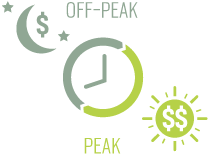Cream Cheese And Time-Of-Use Electricity Pricing
This commentary was originally posted on EDF’s California Dream 2.0 blog.
“The cream cheese just fell off the roof of the car,” my 7-year old daughter said as I turned into my driveway after a trip to the grocery store. Right now you might be asking yourself, “What does this have to do with time-of-use pricing?” Allow me to explain.
We live in Alameda, CA, where plastic bags are prohibited and stores must charge for a paper bag. Alas, I had forgotten to bring a reusable one. To teach my children a lesson and avoid the public scorn (not so much the $0.05 per bag), I carried our groceries and asked the kids to lend their hands. And yes, I put the cream cheese on the roof of the car to free a hand to unlock it.
Once home, I realized that, in addition to almost losing my cream cheese, I’d been making potentially risky tradeoffs. After all, exiting the supermarket with full hands prevented me from holding my children’s hands while crossing a busy – and dangerous – parking lot.
Don’t get me wrong; I’m not lamenting the ban on plastic shopping bags. I think it makes perfect sense, but it takes time to start making the adjustment and the risk tradeoffs aren’t always obvious.
This scenario– making adjustments that may seem inconvenient and a bit scary, but are well worth the effort– plays out in other areas of life as well. Particularly in rethinking how Americans use and pay for electricity.

Most of us don’t think about how the time of day affects the cost of serving us power. In California, we aim to change that by moving to Time-of-Use (TOU) pricing – which will make electricity more expensive during times of peak, or high, energy demand and cheaper off-peak. In fact, just yesterday, the Sacramento Municipal Utility District (SMUD) recommended moving all residential customers to time-of-use rates by 2018 in an effort to give customers more control over energy costs.
EDF believes that TOU pricing will be best for people and the environment, just as banning plastic shopping bags effectively reduces their environmental impact. This approach can encourage conservation and reduce peak energy use while providing customers with more choices that can ultimately lower their monthly bills. Switching to TOU electricity pricing may feel to some like being thrust into a busy parking lot with an armload of groceries and two children to monitor. When should I use my dishwasher? Do I need to reset my air conditioner? Well, yes and no. You can choose to do nothing, or you can exercise a choice you don’t have with our current pricing structure: shifting energy use to times of lower electricity prices. It’s quite doable.
A recent survey of nearly 5,000 customers by PG&E and So Cal Edison found that 75 percent have tried shifting their energy use already – even though they don’t get paid to do it. Two-thirds of respondents said they’d be willing to risk higher bills for the chance to save energy for environmental purposes. This willingness, combined with wise policies – such as the “Try-Before-You-Buy” bill protection that prohibits bill shocks for up to one year after a customer changes rate plans – bodes well for the union of can-do attitudes and technology innovations like digital electricity meters and automated “set-it-and-forget-it” learning thermostats.
The rewards will be significant: TOU pricing will reduce the amount of peak electricity needed from dirty fossil fuel “peaker” power plants, thereby avoiding costs from blackouts and new energy infrastructure investments. It can also help to incorporate more renewable, clean energy resources onto the grid – like wind and solar – with significant benefits for energy independence and reduced air pollution that will put us on a pathway toward stabilizing our climate.

Most consumers will see lower energy bills from TOU electricity pricing without doing anything. Others will need to make adjustments, particularly homes that use a lot of energy during peak energy times of the day. With a little planning, knowledge and helpful technology, it can be as easy as keeping extra shopping bags in your car.
Just as banning plastic bags is helping to reduce environmental degradation, so too can TOU electricity pricing. We just need to get comfortable with the idea. That way we can have our cream cheese and clean environment, too.












